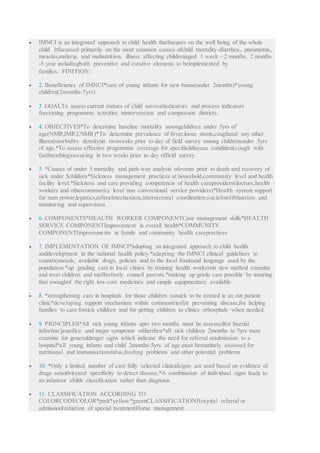
Imnci
- 1. IMNCI is an integrated approach to child health thatfocuses on the well being of the whole child. Itfocussed primarily on the most common causes ofchild mortality-diarrhea, pneumonia, measles,malaria, and malnutrition, illness affecting childrenaged 1 week – 2 months, 2 months -5 year includingboth preventive and curative elements to beimplemented by families.FINITION: 2. Beneficiaries of IMNCI*care of young infants for new borns(under 2months)*young children(2months-5yrs) 3. GOALTo assess current statues of child survivalindicators and process indicators forexisting programme activities inintervention and compassion districts. 4. OBJECTIVES*To determine baseline mortality amongchildren under 5yrs of age(NMR,IMR,USMR)*To determine prevalence of fever,loose stools,coughand any other illness(morbidity density)in twoweeks prior to day of field survey among childrenunder 5yrs of age.*To assess effective programme coverage for specifieddisease condition(cough with fastbreathing)occuring in two weeks prior to day offield survey 5. *Causes of under 5 mortality and path way analysis ofevents prior to death and recovery of sick under 5children*Sickness management practices at household,community level and health facility level.*Sickness and care providing competencis of health careproviders(doctors,health workers and othercommunity level non convectional service providers)*Health system support for man power,legistics,referalmechanism,intersectoral coordination,socialmoliblisation and monitoring and supervision. 6. COMPONENTS*HEALTH WORKER COMPONENTCase management skills*HEALTH SERVICE COMPONENTImprovement in overall health*COMMUNITY COMPONENTImprovements in family and community health carepractices 7. IMPLEMENTATION OF IMNCI*adopting an integrated approach to child health anddevelopment in the national health policy.*adapting the IMNCI clinical guidelines to countriesneeds, available drugs, policies and to the local foodsand language used by the population.*up grading care in local clinics by training health workersin new method examine and treat children and toeffectively council parents.*making up grade care possible by insuring that enoughof the right low-cost medicines and simple equipmentare available. 8. *strengthening care in hospitals for those children toosick to be treated in an out patient clinic*developing support mechanism within communitiesfor preventing disease,for helping families to care forsick children and for getting children to clinics orhospitals when needed. 9. PRINCIPLES*All sick young infants upto two months must be assessedfor baerial infection/jaundice and major symptoms ofdiarrhea*all sick children 2months to 5yrs must examine for generaldanger signs which indicate the need for referral oradmission to a hospital*all young infants and child 2months-5yrs of age must beroutinely assessed for nutritional and immunisationstatus,feeding problems and other potential problems 10. *Only a limited number of care fully selected clinicalsigns are used based on evidence of drugs sensitivityand specificity to detect disease.*A combination of individual signs leads to an infantsor childs classification rather than diagnosis. 11. CLASSIFICATION ACCORDING TO COLORCODECOLOR*pink*yellow*greenCLASSIFICATIONHospital referral or admissionInitiation of special treatmentHome management
- 2. 12. TRAINING IN IMNCITraining is at 2 levels*Inservice training for the existing staff*Pre service training 13. CARE OF CHILDREN ACCORDINGTO IMNCI0-2 MONTHS*keeping the child warm*intiation of breast feeding.*counselling for exclusive breast feeding.*cord,skin and eye care.*recognition of illness in newborn and managementand/referral.*immunisation*home visit in the post natal period. 14. 2MONTHS-5YRS*management of diarrhea,ARI,malaria,measels,acuteear infecton,mal nutrition and anemia.*recognition of illness and risk.*prevention and management of iron and vitaminAdeficiency*counselling on feeding for all chilkdren below 2yrs.*counselling on feeding for malnutrished.*immunization 15. Immunization statusFeeding problemsDoes the infant have diarrheaPossible bacterial infection / jaundiceAssessment of sick young infantupto 2 months 16. Checking for bacterialinfection/jaundice 17. IN CASE OF DIARRHEA 18. Checking skin turgor 19. FEEDING PROBLEM 20. TEACHING & Advice mother to return immediately if danger signspresentAdvice on home care of young infantTeach correct position for breast feeding Teach mother to keep infant warm.COUNSELING 21. Immunization - prophylactic vit A, ironAnamiaMalnutrion diarrheaAsk about main symptoms [coughing/ breathingdifficulty]General danger signsAssessment of young child2 months – 5 years & folicacid supplement 22. In case of diarrhea 23. In case of fever 24. MALNUTRITION 25. ANEMIA 26. IMMUNIZATIONAGE VACCINEBirth BCG , OPV ,Hepatitis6 WEEKS BCG(if not given). OPV-1,HIB 1, DPT 110 WEEKS- POV -2 , DPT 2, HEP B 214 WEEKS OPV 3, DPT 3, HEP B 39MONTHS MEASLES , VIT A16- 18 MONTHS DPT, OPV,VIT A 27. 16 – 36 months - 2 lakh unit 9 months - 1 lakh unitVit A Prophylaxis 28. TREAT DEHYDRATION - ORS 29. IRON & FOLIC ACIDAGE / WEIGHT PAEDIATRIC TABLET4-24 MONTHS (6-12 KG) 1 TABLET2 YRS - 5 YRS ( 12 – 19 KG) 2 TABLETVITAMIN A6 – 12 MONTHS 1 ML12 – 5 YRS 2 ML
- 3. 30. Continue breast feeding if child is sickDo not give any other foodBreast feed as often as child wantFEEDING RECOMMENDATION0-6 MONTHS 31. Wash childs hand before feedingKeep child on your lapGive smashed roti, rice, bread, biscuit, undil: milkor vegetablesBreast feed as often6 – 12 months 32. Wash hands with soapSit by the side of childOffer family foodBreast feed as often12 – 2 yrs 33. > Teach child to wash handsEnsure that child finishes the servingGive family food2 years 34. This approach could help country to achievemillenium goal.Major strength is it use evidence based managementdecisionsIMNCI strategy has emerged as a promising approachto deal with issues related to child survival.CONCLUSION